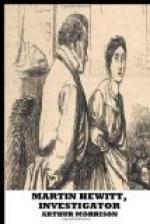* * * * *
The time was half-past one in the afternoon, and Hewitt sat in his inner office examining and comparing the handwriting of two letters by the aid of a large lens. He put down the lens and glanced at the clock on the mantel-piece with a premonition of lunch; and as he did so his clerk quietly entered the room with one of those printed slips which were kept for the announcement of unknown visitors. It was filled up in a hasty and almost illegible hand, thus:
Name of visitor: F. Graham Dixon.
Address: Chancery Lane.
Business: Private and urgent.
“Show Mr. Dixon in,” said Martin Hewitt.
Mr. Dixon was a gaunt, worn-looking man of fifty or so, well, although rather carelessly, dressed, and carrying in his strong, though drawn, face and dullish eyes the look that characterizes the life-long strenuous brain-worker. He leaned forward anxiously in the chair which Hewitt offered him, and told his story with a great deal of very natural agitation.
“You may possibly have heard, Mr. Hewitt—I know there are rumors—of the new locomotive torpedo which the government is about adopting; it is, in fact, the Dixon torpedo, my own invention, and in every respect—not merely in my own opinion, but in that of the government experts—by far the most efficient and certain yet produced. It will travel at least four hundred yards farther than any torpedo now made, with perfect accuracy of aim (a very great desideratum, let me tell you), and will carry an unprecedentedly heavy charge. There are other advantages—speed, simple discharge, and so forth—that I needn’t bother you about. The machine is the result of many years of work and disappointment, and its design has only been arrived at by a careful balancing of principles and means, which are expressed on the only four existing sets of drawings. The whole thing, I need hardly tell you, is a profound secret, and you may judge of my present state of mind when I tell you that one set of drawings has been stolen.”
“From your house?”
“From my office, in Chancery Lane, this morning. The four sets of drawings were distributed thus: Two were at the Admiralty Office, one being a finished set on thick paper, and the other a set of tracings therefrom; and the other two were at my own office, one being a penciled set, uncolored—a sort of finished draft, you understand—and the other a set of tracings similar to those at the Admiralty. It is this last set that has gone. The two sets were kept together in one drawer in my room. Both were there at ten this morning; of that I am sure, for I had to go to that very drawer for something else when I first arrived. But at twelve the tracings had vanished.”
“You suspect somebody, probably?”
“I can not. It is a most extraordinary thing. Nobody has left the office (except myself, and then only to come to you) since ten this morning, and there has been no visitor. And yet the drawings are gone!”




